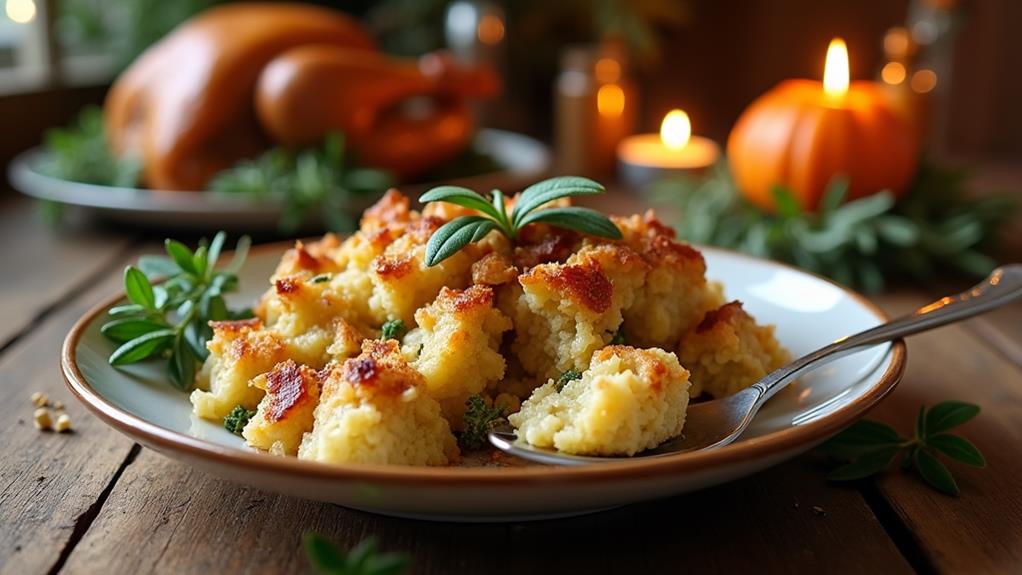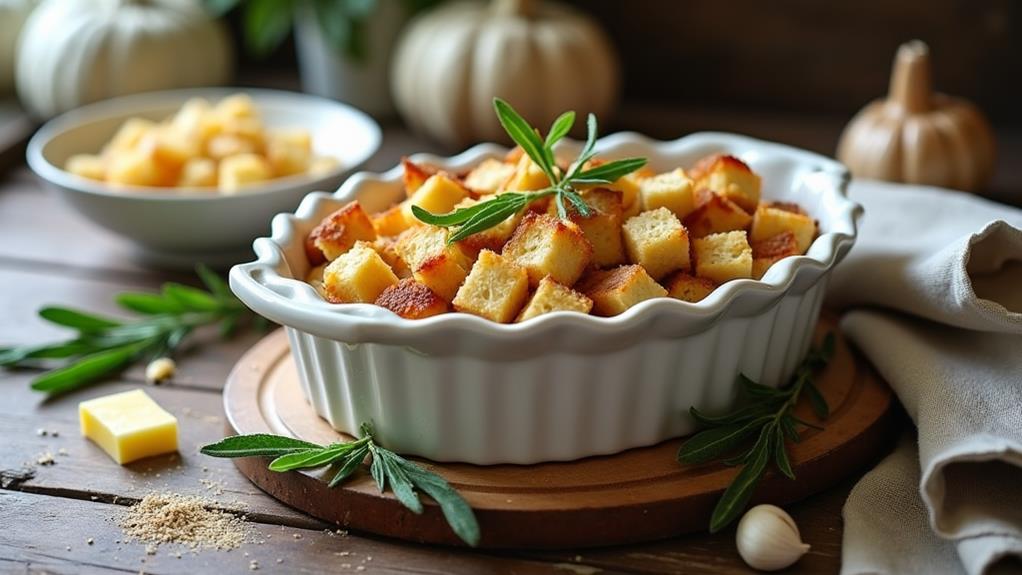The stuffing is like a warm embrace on a cold winter day, embodying the essence of comfort food in British cuisine. You might find it intriguing how this simple blend of sage and onion has not only survived the test of time but continues to be a staple at festive gatherings. As you explore its rich history and the various ways it can be prepared, you'll uncover the secrets that make this dish a beloved tradition, and perhaps, it'll inspire you to rethink your own holiday meals.
History
Exploring the history of sage and onion stuffing reveals its deep roots in British cuisine. This delightful dish has been warming hearts and filling bellies for centuries, making it a staple at many traditional gatherings.
You might be surprised to learn that its historical origins can be traced back to the medieval times when herbs were essential for flavor and preservation. Sage, with its earthy aroma, became a favorite for adding depth to dishes, while onions provided sweetness and moisture.
As you prepare to serve this comforting stuffing, think about its cultural significance. It's more than just a side dish; it's a symbol of togetherness, often enjoyed during festive occasions like Christmas and Sunday roasts. Families would gather around the table, sharing stories and laughter, all while savoring the warm, savory notes of sage and onion.
Today, you can carry on this tradition by including sage and onion stuffing in your meals. Not only does it honor the past, but it also invites your loved ones to create new memories.
Recipe

Traditional Sage and Onion Stuffing is a classic accompaniment that enhances the flavor of roasted meats, particularly turkey and chicken, making it a staple during festive occasions. This savory mixture combines the earthy notes of sage with the sweetness of onions, creating a delightful contrast that elevates any meal. The stuffing can be cooked inside the bird or baked separately, allowing for versatility depending on your preference.
Making this stuffing is a straightforward process that brings together simple ingredients for a delicious outcome. The key to achieving the best flavor lies in properly sautéing the onions and allowing the sage to infuse its aromatic qualities into the mixture. Whether served during the holidays or as a comforting addition to a weeknight dinner, this Sage and Onion Stuffing is sure to please.
Ingredients:
- 4 cups stale bread cubes
- 2 medium onions, finely chopped
- 4 tablespoons butter
- 2 tablespoons fresh sage, chopped (or 1 tablespoon dried sage)
- 1 teaspoon salt
- 1/2 teaspoon black pepper
- 1/4 cup chicken or vegetable broth
- 1/4 teaspoon nutmeg (optional)
In a large skillet, melt the butter over medium heat. Add the chopped onions and sauté until they're soft and translucent, about 5-7 minutes. Stir in the sage, salt, and pepper, and cook for an additional 2 minutes.
In a large bowl, combine the stale bread cubes with the sautéed onion mixture. Pour in the broth and mix everything together until the bread is well moistened. If desired, add nutmeg for an extra layer of flavor.
Transfer the stuffing to a greased baking dish, cover with foil, and bake at 350°F (175°C) for 25-30 minutes. Remove the foil and bake for an additional 10-15 minutes, or until the top is golden brown and crispy.
For the best results, use a variety of bread for a more complex texture and flavor; sourdough or whole grain can add an interesting twist. Additionally, if you prefer a more moist stuffing, adjust the amount of broth to your liking.
You can also add additional ingredients like diced celery, apples, or nuts for extra flavor and texture. Just be sure to account for any changes in baking time if you increase the volume of the stuffing.
Similar dishes include cornbread stuffing or mushroom stuffing, both of which also highlight the comforting flavors of herbs and vegetables. Variations can include adding sausage or bacon for a heartier option, or incorporating dried fruits like cranberries for a touch of sweetness.
Final Notes
When preparing your Sage and Onion Stuffing, keep in mind that the key to a delicious result lies in the quality of your ingredients and your personal preferences. Choosing fresh herbs, high-quality bread, and a good stock can elevate your dish to new heights.
Don't hesitate to experiment and make it your own!
When it comes to serving suggestions, this stuffing pairs beautifully with roast chicken or turkey, making it a perfect addition to any festive gathering.
You can even serve it as a side dish alongside a hearty vegetable stew for a comforting meal.
If you're feeling adventurous, consider some flavor variations! Adding dried fruits like cranberries or apricots can introduce a sweet touch, while nuts can provide a satisfying crunch.
You might also try incorporating spices like garlic or even some grated cheese for a rich, savory twist.

